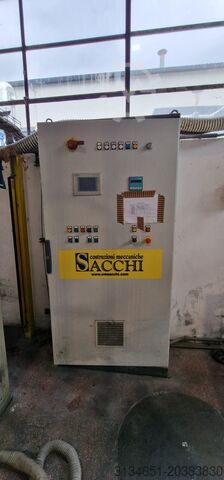Γραμμή σακιών και παλετοποιήσηςF.lli Sacchi
Linea insacco e pallettizzazione “Smart
Γραμμή σακιών και παλετοποιήσης
F.lli Sacchi
Linea insacco e pallettizzazione “Smart
Έτος κατασκευής
2012
Κατάσταση
Μεταχειρισμένο
Τοποθεσία
Casalgrande 

Προβολή φωτογραφιών
Εμφάνιση χάρτη
Στοιχεία για το μηχάνημα
- Περιγραφή μηχανήματος:
- Γραμμή σακιών και παλετοποιήσης
- Κατασκευαστής:
- F.lli Sacchi
- Έτος κατασκευής:
- 2012
- Κατάσταση:
- μεταχειρισμένο
- Λειτουργικότητα:
- πλήρως λειτουργικό
Τιμή & Τοποθεσία
- Τοποθεσία:
- Strada Statale 467 106, 42013 Casalgrande, Italia

Κλήση
Λεπτομέρειες προσφοράς
- ID Καταχώρησης:
- A203-83830
- Τελευταία ενημέρωση:
- στις 27.10.2025
Περιγραφή
The system consists of the following components:
- Platform on which the vibrated base for supporting the bin is mounted. This platform is protected by perimeter railings and accessed via a fixed vertical ladder (also known as a 'ship ladder').
- Empty bag storage. Empty bags are manually loaded by the operator. The exact position of the bags is determined by adjustable side guides; a sensor beneath the stack indicates when the supply of bags has been depleted.
- Pneumatic cylinders, mounted on the empty bag magazine, handle picking a bag, opening its mouth, and inserting it into the dosing spout. Bag picking is performed by a set of suction cups. The supporting frame of the magazine also houses the pneumatic control panel QP1.
- The dosing spout is supported by three load cells. The discharge is equipped with a bucket-type gate actuated by two pneumatic cylinders. Beside it are two more cylinders with hooks at the ends to tension the bag’s mouth.
- Bags are clamped along the long side by two jaws that grip the bag after filling, conveying it to the bag stitching machine. Movement is performed with geared motor units and wheels sliding on chromed shafts. During this phase, the bag rests on a powered conveyor belt for transfer. This belt can be raised by a pneumatic cylinder to gently support the bag after filling is complete. Height adjustment is manual via a handwheel acting on four jacks to suit different bag sizes.
- Once the bag reaches the sewing machine, stitching and thread cutting occur. Still on the conveyor, the bag moves to the bag turning station, where it is clamped by two jaws, rotated 90 degrees, and released in parallel alignment with the conveyor.
- The next conveyor section features a series of square rollers to flatten the bag, followed by a belt for advancement.
- At the end is a roller conveyor where the bag is picked up by a robot. The conveyor stops via a photocell when the bag reaches the end.
Itsdpfsxrcc Asx Ah Hsr
- The robot's gripper is a comb-type and features a translating cylinder for bag release and two cylinders driving a plate to clamp the bag during handling before unloading.
- Two boxes containing solenoid valves and vacuum units are installed on the system.
- One electrical panel controls the whole system, equipped with an HMI (operator panel) and a weighing module.
- The robot is managed by its own dedicated control panel featuring an operator interface.
Η διαφήμιση μεταφράστηκε αυτόματα και ενδέχεται να περιέχει ορισμένα σφάλματα μετάφρασης.
- Platform on which the vibrated base for supporting the bin is mounted. This platform is protected by perimeter railings and accessed via a fixed vertical ladder (also known as a 'ship ladder').
- Empty bag storage. Empty bags are manually loaded by the operator. The exact position of the bags is determined by adjustable side guides; a sensor beneath the stack indicates when the supply of bags has been depleted.
- Pneumatic cylinders, mounted on the empty bag magazine, handle picking a bag, opening its mouth, and inserting it into the dosing spout. Bag picking is performed by a set of suction cups. The supporting frame of the magazine also houses the pneumatic control panel QP1.
- The dosing spout is supported by three load cells. The discharge is equipped with a bucket-type gate actuated by two pneumatic cylinders. Beside it are two more cylinders with hooks at the ends to tension the bag’s mouth.
- Bags are clamped along the long side by two jaws that grip the bag after filling, conveying it to the bag stitching machine. Movement is performed with geared motor units and wheels sliding on chromed shafts. During this phase, the bag rests on a powered conveyor belt for transfer. This belt can be raised by a pneumatic cylinder to gently support the bag after filling is complete. Height adjustment is manual via a handwheel acting on four jacks to suit different bag sizes.
- Once the bag reaches the sewing machine, stitching and thread cutting occur. Still on the conveyor, the bag moves to the bag turning station, where it is clamped by two jaws, rotated 90 degrees, and released in parallel alignment with the conveyor.
- The next conveyor section features a series of square rollers to flatten the bag, followed by a belt for advancement.
- At the end is a roller conveyor where the bag is picked up by a robot. The conveyor stops via a photocell when the bag reaches the end.
Itsdpfsxrcc Asx Ah Hsr
- The robot's gripper is a comb-type and features a translating cylinder for bag release and two cylinders driving a plate to clamp the bag during handling before unloading.
- Two boxes containing solenoid valves and vacuum units are installed on the system.
- One electrical panel controls the whole system, equipped with an HMI (operator panel) and a weighing module.
- The robot is managed by its own dedicated control panel featuring an operator interface.
Η διαφήμιση μεταφράστηκε αυτόματα και ενδέχεται να περιέχει ορισμένα σφάλματα μετάφρασης.
Προμηθευτής
Σημείωση: Εγγραφείτε δωρεάν ή συνδεθείτε, για να αποκτήσετε πρόσβαση σε όλες τις πληροφορίες.
Υποβολή αιτήματος
Τηλέφωνο & Φαξ
+39 0522 ... αγγελίες
Η αγγελία σας διαγράφηκε με επιτυχία
Παρουσιάστηκε σφάλμα











































